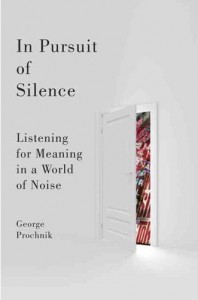By George Prochnik
Reviewed by Alice V. Feeley Writing Workshop Participant ’08
Doubleday, 342 pp., $26.00
Readers attracted to this book’s title need to know that its subtitle is equally important. Rather than offering a targeted “how to” book presenting methods for achieving silence, George Prochnik takes readers on a companionable journey. Prochnik, who received a 2007 Gradiva Award for Putnam Camp: Sigmund Freud, James Jackson Putnam, and the Purpose of American Psychology, here explores the world of noise, beginning in his own Brooklyn neighborhood; stopping at a monastery in Dubuque; and then extending his research to such geographical outposts as Oregon and Copenhagen. Prochnik’s explorations of noise and silence—through a pilgrimage that organically integrates interviews, historic happenings and present day initiatives—are filled with many more questions than answers. “What has led people to think of silence as reflective of God’s nature?” he asks. Or, given the abundance of evidence for the negative consequences of noise, “why would we make so much of it intentionally?”
Prochnik’s style draws the reader into the surprises and questions of his discoveries in the world of noise, as well as into the saving interruptions of silence. While I can no longer enter a store, mall or restaurant without questioning the specific manipulative aspects of any music being played, I am also aware of a related discovery presented by Prochnik: Prehistoric shamans used reverberations, echoes, amplification and resonance for inducing a state of high emotion and minimal reason.
Military personnel make Prochnik aware that a dimension of silence enters combat situations. Aural exclusion is necessary for stress management and problem solving, and combatants are able to make a changeover from listening to seeing. It seems that the mind can create silence where actual silence is least present.
Although the author owns up to a personal passion for quiet, he is here very much interested in the collective, with its psychological and sociological dimensions. Noise as a way of magnifying one’s own sphere of power is exemplified in Prochnik’s experience of the boom car. He makes tentative links between the expanding use of the iPod and the diminished sense of freedom of movement experienced by city dwellers. He considers noise as a way of blocking out other noise—noise as a way of forgetting the larger world.
Prochnik’s participation in an ancient Japanese tea ceremony and his visit to Gallaudet University, the leading university for the deaf, present possibilities of silence for which readers may long. We learn that architecture designed to facilitate silent communication enlarges our relationship with the world. Many educators will be pleased with Prochnik’s argument for educating children in public schools to value silence. Many readers will be energized by his call to dedicate our efforts less to reducing noise and more to increasing silence.
Alice V. Feeley, RDC attended the Collegeville Institute’s summer writing workshop Believing in Writing in 2008. She is the author of Armed Pilgrims, a collection of poetry that resulted from her work at the Institute.
Like this post? Subscribe to have new posts sent to you by email the same day they are posted.




Leave a Reply